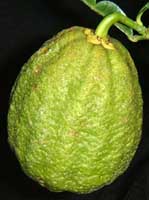Citrus cavaleriei
(Redirected from Citrus ichangensis)
Citrus cavaleriei is a species of citrus plant in the family Rutaceae. It is native to China and is known for its distinctive fruit and foliage. This species is sometimes referred to as the Ichang papeda.
Description[edit | edit source]
Citrus cavaleriei is a small to medium-sized tree that can grow up to 5 meters in height. The leaves are dark green, glossy, and have a characteristic winged petiole. The flowers are white and fragrant, typically blooming in the spring. The fruit is small, round, and has a thick, bumpy rind. The flesh of the fruit is acidic and not commonly consumed fresh but is sometimes used in traditional Chinese cuisine.
Habitat and Distribution[edit | edit source]
Citrus cavaleriei is primarily found in the mountainous regions of southwestern China, particularly in the provinces of Guizhou, Hunan, and Sichuan. It thrives in subtropical climates and is often found in forested areas at elevations between 500 and 1500 meters.
Uses[edit | edit source]
While the fruit of Citrus cavaleriei is not widely consumed due to its sour taste, it is sometimes used in local culinary practices. The plant is also valued for its potential use in citrus breeding programs due to its resistance to certain diseases and pests. Additionally, the essential oils extracted from the leaves and fruit have applications in traditional medicine and aromatherapy.
Cultivation[edit | edit source]
Citrus cavaleriei is cultivated in a manner similar to other citrus species. It requires well-drained soil, adequate sunlight, and protection from frost. Propagation is typically done through grafting onto rootstocks that are resistant to soil-borne diseases.
Related Species[edit | edit source]
Citrus cavaleriei is closely related to other members of the Citrus genus, including:
See Also[edit | edit source]
References[edit | edit source]
External Links[edit | edit source]
Search WikiMD
Ad.Tired of being Overweight? Try W8MD's physician weight loss program.
Semaglutide (Ozempic / Wegovy and Tirzepatide (Mounjaro / Zepbound) available.
Advertise on WikiMD
|
WikiMD's Wellness Encyclopedia |
| Let Food Be Thy Medicine Medicine Thy Food - Hippocrates |
Translate this page: - East Asian
中文,
日本,
한국어,
South Asian
हिन्दी,
தமிழ்,
తెలుగు,
Urdu,
ಕನ್ನಡ,
Southeast Asian
Indonesian,
Vietnamese,
Thai,
မြန်မာဘာသာ,
বাংলা
European
español,
Deutsch,
français,
Greek,
português do Brasil,
polski,
română,
русский,
Nederlands,
norsk,
svenska,
suomi,
Italian
Middle Eastern & African
عربى,
Turkish,
Persian,
Hebrew,
Afrikaans,
isiZulu,
Kiswahili,
Other
Bulgarian,
Hungarian,
Czech,
Swedish,
മലയാളം,
मराठी,
ਪੰਜਾਬੀ,
ગુજરાતી,
Portuguese,
Ukrainian
Medical Disclaimer: WikiMD is not a substitute for professional medical advice. The information on WikiMD is provided as an information resource only, may be incorrect, outdated or misleading, and is not to be used or relied on for any diagnostic or treatment purposes. Please consult your health care provider before making any healthcare decisions or for guidance about a specific medical condition. WikiMD expressly disclaims responsibility, and shall have no liability, for any damages, loss, injury, or liability whatsoever suffered as a result of your reliance on the information contained in this site. By visiting this site you agree to the foregoing terms and conditions, which may from time to time be changed or supplemented by WikiMD. If you do not agree to the foregoing terms and conditions, you should not enter or use this site. See full disclaimer.
Credits:Most images are courtesy of Wikimedia commons, and templates, categories Wikipedia, licensed under CC BY SA or similar.
Contributors: Prab R. Tumpati, MD

